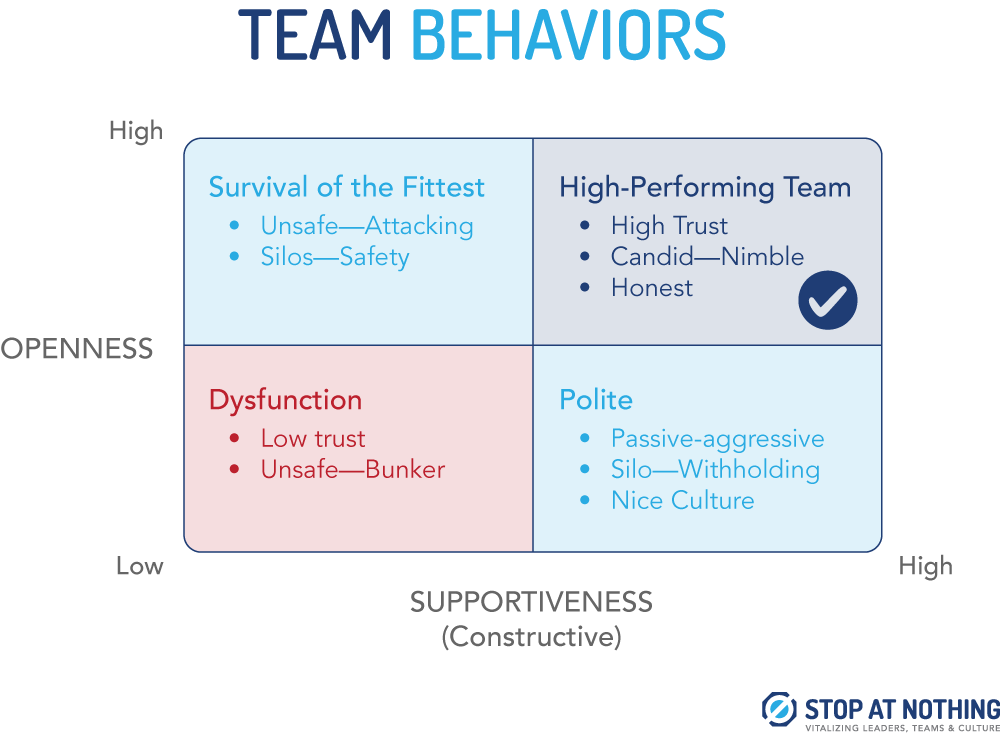By Cecilia Calderón – May 2023
Effective leadership is one of the most important aspects of any successful business. One element of building and nurturing a high-performing team that has been gaining significant attention lately is something known as Psychological Safety.

I work with leaders across the country, and, despite their varied industries, they all tend to agree on the idea of Psychological Safety (PS). However, when we work together to explore PS deeper, there is often a covert resistance. In my experience, this is due to two issues. First, a lack of understanding of what PS is and, second, the fear of vulnerability often required to create, sustain, and grow Psychological Safety.
First things first. Let’s define Psychological Safety.
Psychological Safety is the belief that team members feel safe to take risks and openly express themselves without fear of being judged or punished.
Amy Edmonson, the Harvard professor and researcher who coined the term, says PS is “a shared belief held by members of a team that the team is safe for interpersonal risk-taking.” So, the team has the confidence that candor and vulnerability are okay.
Therefore, it is essential to note that PS lives at the group/team level—where everything happens through conversations, and team success and effectiveness will depend on the quality of those conversations.
Do your conversations create, promote, and reinforce Psychological Safety?
When Psychological Safety exists, performance, engagement, trust, innovation, collaboration, and effectiveness are maximized.
Here are some distinctions of what Psychological Safety is and is not:
- Psychological Safety is not about being pleasant and cordial. It is not about complacency and definitely not about lowering performance standards. On the contrary, Psychological Safety is all about high performance.
- Psychological Safety is about feeling safe to speak up, share ideas, ask for help, recognize mistakes, take risks, share concerns, and have open and difficult conversations.
In general, when we spend a lot of time managing impressions (trying to appear intelligent, helpful, positive, competent) because we fear being perceived as not-knowing, difficult, or negative, we tend not to ask questions or offer opinions. We shy away from disagreements, and we do not own up to weaknesses or mistakes. Instead, we blame and become critical of others and don’t reevaluate and apologize when we should.
In work environments where you see these behaviors, Psychological Safety does not exist. The free exchange of ideas, concerns, and worries is thwarted. The impact on team performance is evident and can even be catastrophic to the productivity of a team.
Knowing and understanding the need to change certain behaviors is not always enough to create the change. It is hard because so many things are below the surface that often, without our intention, impact how we show up. Vulnerability is a big part of this. Vulnerability is often seen as a weakness, and no one wants to be perceived as weak, so we either push hard or shrink and withdraw.
But, if we all theoretically agree on Psychological Safety and the behaviors that underpin it, why is it so hard to enact in our businesses?
Inspired by Amy Edmondson and Brené Brown, here are a few true-or-false statements to get an idea of your team’s level of Psychological Safety. How would your team members answer these questions?
- If you make a mistake on this team, it is often held against you.
- Perfectionism is reinforced in this team.
- Members of this team can bring up problems and tough issues.
- Members of this team use criticism and blame when things go wrong.
- People in this team avoid difficult conversations.
- It is safe to take a risk on this team.
- People in this team sacrifice clarity and directness to seem polite.
- It is difficult to ask other members of this team for help.
- It is difficult to offer other members of this team help.
- No one on this team would deliberately act in a way that undermines my efforts.
- Working with members of this team, my unique skills and talents are valued and utilized.
The Team Behaviors Model
We often use this model with executives to help implement Psychological Safety in a grounded and clear way.

What does Openness mean?
The willingness and commitment to be transparent, clear, specific, and direct. For this to occur, team members must be willing to take conversational risks.
What does Supportive/Constructive mean?
Caring for, and about, interpersonal relationships and being respectful and generous in our assumptions about other people’s words and behaviors.
Openness and Supportive are NOT mutually exclusive. On the contrary, they must work together for High Performance to exist. In my view, they constitute what PS is all about.
Low Openness and Low Supportive:
No one is talking to each other. Everyone feels and is on their own. “You do not bother me, and I do not bother you” mentality. Lots of silos. Very low trust and Bunker mentality. Highly Dysfunctional.
High Openness and Low Supportive:
Very unsafe, with lots of grenade throwing, attacking others, and blaming. Silos remain.
Low Openness and High Supportive:
This is where most teams are. It is a polite “we are nice here” culture. People will create workarounds to avoid causing a problem. Sarcasm emerges, as well as passive aggressiveness when things get complicated. People here believe that Openness and Supportive cannot co-exist and prefer Supportive vs. Openness.
High Openness and High Supportive:
Here is where the High Performing team lives. There are high levels of trust. Team members have each other’s back. They are direct, honest, and caring. This makes teams more nimble. Real conversations happen. They know and expect conflict will arise and feel safe agreeing or disagreeing with each other productively.
To be a successful team, the members should feel safe to ask for help, admit to failure, push back, ask questions, make and own mistakes, speak up, and offer ideas. And as leaders and peers, we must encourage, model, and reinforce the elements of Openness and Support to keep our organization functioning at its best.
If your team’s effectiveness and how you are encouraging High Performing teams need a tune-up, reach out—we would be thrilled to work with you.

